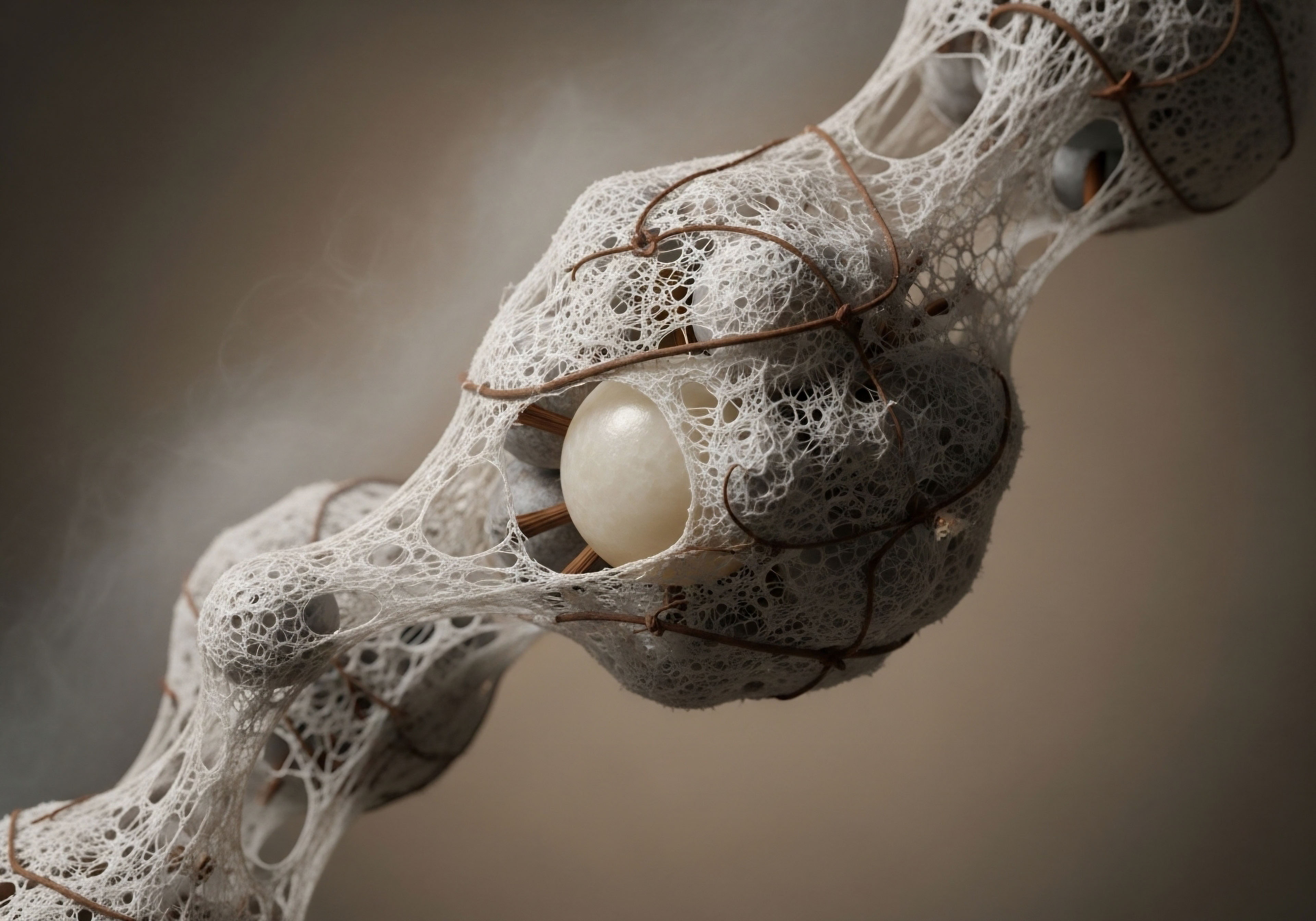

Fundamentals
You may have found yourself on a path to reclaim your vitality, meticulously addressing one aspect of your hormonal health, only to feel that the full picture of wellness remains just out of reach. It is a common experience.
You begin a protocol like Testosterone Replacement Therapy (TRT) and see improvements in certain areas ∞ perhaps energy or libido ∞ yet a persistent sense of being less than your best lingers. This feeling points to a profound biological reality ∞ your body operates as an integrated system, a network of interconnected pathways where no single hormone functions in isolation.
Optimizing one pathway while neglecting another is akin to meticulously tuning a single instrument in an orchestra; the overall performance depends on every section playing in concert.
The conversation about hormonal optimization often begins with the gonads, focusing on testosterone and estrogen. This is the domain of the Hypothalamic-Pituitary-Gonadal (HPG) axis, the command-and-control system for reproductive health and much of what we associate with vigor and drive.
When this axis falters, as it does with age or certain health conditions, protocols like TRT are designed to restore function by directly supplementing the primary hormone, testosterone. This is a foundational and often necessary step in rebuilding your physiological baseline.
True wellness arises from understanding that hormonal pathways are interconnected, and addressing them as a unified system is key to comprehensive results.
There is another equally powerful system working in parallel ∞ the Hypothalamic-Pituitary-Somatotropic (HPS) axis. This system governs the release of human growth hormone (GH), a master signaling molecule responsible for cellular repair, metabolism, body composition, and deep, restorative sleep. As with the HPG axis, the function of the HPS axis declines with age.
This decline contributes to symptoms that may be familiar ∞ stubborn body fat, a loss of muscle tone, slower recovery from exercise, and a general feeling of fatigue that sleep does not seem to resolve. These are precisely the symptoms that TRT alone may not fully correct.

What Is the Role of Growth Hormone Releasing Peptides?
This is where Growth Hormone Releasing Peptides (GHRPs) enter the clinical picture. These are not synthetic growth hormones. They are sophisticated signaling molecules, short chains of amino acids that communicate directly with your pituitary gland. Their function is to prompt your body to produce and release its own growth hormone in a manner that mimics your natural, youthful physiological rhythms.
Peptides like Sermorelin, Ipamorelin, and CJC-1295 are GHRH analogs or ghrelin mimetics; they act as precise keys to unlock your body’s own latent potential for repair and rejuvenation. They restore a vital signaling conversation that has quieted over time.
Integrating these two approaches allows for a more complete recalibration of your endocrine system. You are addressing both the gonadal and the somatotropic axes simultaneously. The testosterone protocol provides the direct anabolic and androgenic signals essential for male and female health, while the peptide protocol restores the body’s deep, systemic repair and metabolic regulation mechanisms.
The result is a synergy where the whole becomes substantially greater than the sum of its parts. You are moving from simple hormone replacement to a sophisticated, systems-based approach to wellness, creating an internal environment where all your physiological systems can communicate and function cohesively.


Intermediate
Understanding the potential for synergy between Growth Hormone Releasing Peptides and other hormonal protocols requires a closer look at their distinct mechanisms and complementary effects. When a clinician designs an integrated protocol, the goal is to create a multi-layered support system for your body’s endocrine network. This moves the therapeutic model from merely topping off a depleted resource to restoring the operational integrity of the underlying systems.

Protocols for Systemic Recalibration
A well-structured wellness plan is tailored to the individual’s unique biochemistry, symptoms, and goals. For many, this involves the concurrent use of TRT and a GHRP. Let’s examine the clinical architecture of such a protocol.
Testosterone Replacement Therapy (TRT) ∞ For men, a standard protocol often involves weekly intramuscular or subcutaneous injections of Testosterone Cypionate. This provides a steady, exogenous supply of the body’s primary androgenic hormone. To maintain testicular function and mitigate side effects, this is frequently paired with Gonadorelin, which stimulates the pituitary to release Luteinizing Hormone (LH), and an aromatase inhibitor like Anastrozole to manage the conversion of testosterone to estrogen.
For women, lower doses of Testosterone Cypionate can be used to address symptoms like low libido and fatigue, often in conjunction with progesterone to ensure overall hormonal balance.
Growth Hormone Peptide Therapy ∞ This protocol runs on a parallel track. Peptides like Ipamorelin are often combined with a GHRH analog like CJC-1295. Ipamorelin is a ghrelin mimetic that stimulates a strong, clean pulse of GH from the pituitary without significantly affecting cortisol or prolactin.
CJC-1295 is a long-acting GHRH analog that elevates the baseline levels of growth hormone, creating a sustained environment for tissue repair and metabolic efficiency. They are typically administered via subcutaneous injection before bedtime, capitalizing on the body’s natural nocturnal GH pulse.
Combining TRT with GH-releasing peptides creates a synergistic effect, where improved metabolic function from GH enhances the anabolic and wellness benefits of testosterone.
The table below outlines the distinct and overlapping functions of these two protocol types.
| Therapeutic Protocol | Primary Biological Axis | Key Physiological Effects | Common Administrative Method |
|---|---|---|---|
| Testosterone Replacement Therapy (TRT) | Hypothalamic-Pituitary-Gonadal (HPG) Axis | Increases libido, energy, and mood; Supports muscle mass and bone density; Improves cognitive function. | Weekly Intramuscular/Subcutaneous Injection |
| Growth Hormone Peptide Therapy (GHRP) | Hypothalamic-Pituitary-Somatotropic (HPS) Axis | Promotes fat loss (lipolysis); Enhances muscle repair and growth; Improves sleep quality; Supports collagen synthesis and skin elasticity. | Daily Subcutaneous Injection (often nocturnal) |

How Do These Protocols Create Synergy?
The integration of these therapies yields benefits that neither can achieve alone. Growth hormone and its primary mediator, Insulin-Like Growth Factor 1 (IGF-1), have profound effects on metabolism. Improved GH/IGF-1 signaling enhances insulin sensitivity, meaning your body becomes more efficient at utilizing glucose for energy instead of storing it as fat.
This metabolic improvement creates a more favorable internal environment for testosterone to exert its anabolic effects. Better insulin sensitivity can reduce systemic inflammation, a factor that can suppress testosterone production and blunt its effectiveness at the cellular level.
Furthermore, the benefits compound. The improved sleep quality driven by GHRPs leads to better overnight recovery and a more robust natural cortisol rhythm. A healthy cortisol pattern is essential for optimal testosterone function. The direct anabolic effect of testosterone on muscle tissue is amplified by the enhanced repair and recovery signals from the GH/IGF-1 axis.
This results in more significant improvements in lean body mass and strength than one would see with TRT alone. This combined approach addresses a wider spectrum of age-related decline, targeting energy, body composition, recovery, and overall vitality from two distinct but cooperative angles.
- Metabolic Enhancement ∞ GHRPs improve insulin sensitivity and promote lipolysis, creating an ideal state for testosterone to build lean tissue.
- Recovery Amplification ∞ The deep, restorative sleep promoted by peptides enhances the body’s response to the anabolic signals of testosterone.
- System-Wide Communication ∞ This dual-axis approach restores a more complete and youthful hormonal signaling environment, addressing a broader range of symptoms.


Academic
A sophisticated clinical approach to comprehensive wellness requires moving beyond the mere supplementation of hormones to the strategic modulation of the body’s core endocrine signaling networks. The integration of Growth Hormone Releasing Peptides (GHRPs) with established Hormone Replacement Therapy (HRT) protocols, such as TRT, represents a shift towards a systems-biology model of age management and metabolic optimization.
This strategy is grounded in the understanding that the somatotropic and gonadal axes are deeply intertwined, with bidirectional communication influencing everything from cellular metabolism to gene expression.

Mechanisms of a Multi-Axis Endocrine Strategy
At the molecular level, the synergy between testosterone and the GH/IGF-1 axis is profound. Testosterone’s primary mechanism is genomic; it binds to androgen receptors in the cytoplasm, and this complex then translocates to the cell nucleus to act as a transcription factor, altering the expression of genes related to muscle protein synthesis.
The GH/IGF-1 axis complements this action through both genomic and non-genomic pathways. When GHRPs stimulate the pituitary to release growth hormone, it travels to the liver and other peripheral tissues, where it stimulates the production of IGF-1.
IGF-1 is a potent activator of the PI3K/Akt/mTOR pathway, a central signaling cascade that governs cell growth, proliferation, and survival. Activation of this pathway is a powerful stimulus for protein synthesis in skeletal muscle. Concurrently, testosterone is also known to potentiate this pathway.
The presence of optimal levels of both testosterone and IGF-1 creates a powerful, coordinated stimulus for muscle hypertrophy and repair. One signal primes the cellular machinery, and the other provides a potent, complementary activation signal. This creates a physiological environment where the response to stimuli like resistance training is significantly amplified.
The coordinated activation of androgen receptors by testosterone and the PI3K/Akt/mTOR pathway by IGF-1 provides a powerful, multi-faceted stimulus for cellular growth and repair.
The table below differentiates the primary mechanisms of action for various classes of peptides used in these integrated protocols.
| Peptide Class | Example(s) | Primary Mechanism of Action | Key Physiological Characteristic |
|---|---|---|---|
| GHRH Analogs | Sermorelin, CJC-1295 | Binds to GHRH receptors on the pituitary, stimulating the synthesis and release of Growth Hormone. | Increases the amplitude and frequency of natural GH pulses, respecting the endogenous feedback loop. |
| Ghrelin Mimetics / GH Secretagogues | Ipamorelin, Hexarelin, MK-677 | Binds to the GHSR-1a receptor in the pituitary and hypothalamus, stimulating a pulse of GH. | Initiates a strong GH release pulse independent of GHRH levels; some have effects on appetite. |
| Post-TRT Stimulation | Gonadorelin | A GnRH analog that stimulates the pituitary to release LH and FSH. | Used to maintain or restore endogenous testosterone production and spermatogenesis. |

What Are the Downstream Metabolic Implications?
The integration of these therapies extends well into metabolic regulation. A decline in the somatotropic axis is a key contributor to the development of age-related visceral adiposity and insulin resistance. GH is a potent lipolytic agent, meaning it directly signals fat cells to release stored triglycerides into the bloodstream to be used for energy.
This action is particularly effective on visceral fat, the metabolically active fat stored around the organs that is a major driver of systemic inflammation and metabolic disease.
By improving body composition and reducing visceral fat, GHRPs lower the chronic inflammatory load on the body. This reduction in inflammatory cytokines, such as TNF-alpha and IL-6, has a direct, positive effect on the gonadal axis. Chronic inflammation is known to suppress hypothalamic function and testicular Leydig cell steroidogenesis.
Therefore, by resolving a key source of inflammation through the HPS axis, you create more favorable conditions for the HPG axis to function, whether it is being supported by TRT or stimulated to produce its own testosterone. Preliminary studies on combined GH and testosterone therapy in specific patient populations, such as those with heart failure, have suggested the approach is safe and may offer therapeutic benefits beyond single-hormone protocols, supporting the concept of addressing multiple hormonal deficiencies concurrently.
This integrated methodology represents a more complete restoration of an optimized, youthful endocrine state. It addresses the direct anabolic and androgenic signaling with testosterone while simultaneously restoring the body’s fundamental processes of repair, recovery, and metabolic efficiency through the targeted stimulation of the growth hormone axis. The result is a more robust and resilient physiological state.

References
- Sand Institute. “TRT testosterone replacement therapy combined with the use of a GHRH Peptide (growth hormone releasing hormone) secreatogue in men with Secondary Hypogonadism.” 2019.
- Aversa, Antonio, et al. “Combined effects of growth hormone and testosterone replacement treatment in heart failure.” Journal of Cachexia, Sarcopenia and Muscle, 2016.
- “Boosting Testosterone ∞ Unleashing the Potential of Peptides.” Vitality Aesthetic & Regenerative Medicine, 2024.
- “The Research Behind Peptides for Testosterone.” Limitless Life Nootropics, 2025.
- “Peptide Therapy – Next Level TRT.” Next Level TRT, no date.

Reflection
The information presented here provides a map of the biological systems that govern your vitality. It details the clinical tools and strategies that can be used to navigate the complex terrain of hormonal health. This knowledge is the foundational step. The next, more personal step involves introspection.
What does optimal function truly feel like for you? What aspects of your life ∞ be it physical performance, mental clarity, or emotional resilience ∞ do you wish to reclaim or enhance? Understanding the science is about empowering you to ask more precise questions and to set more intentional goals for your own health journey.
Your unique biology and personal aspirations are the true starting point for creating a protocol that does not just adjust numbers on a lab report, but genuinely restores you to your fullest potential.



